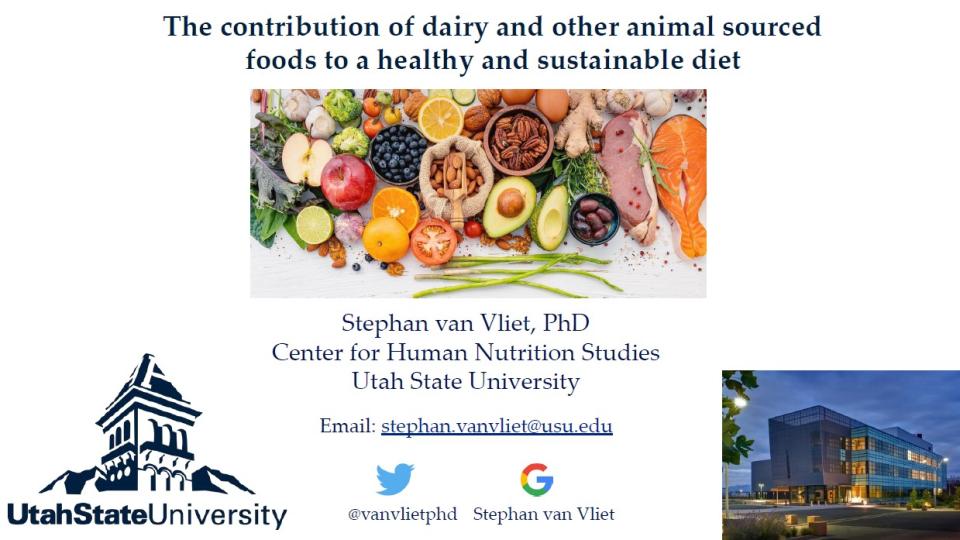
The contributions of dairy and animal sourced foods to a healthy diet
Webinar
The increasing prevalence of micronutrient deficiencies across all income statuses makes nutrition awareness essential for promoting optimal health through informed dietary changes. In this webinar, Dr. Stephan van Vliet (assistant professor, Utah State University) raises awareness on micronutrient deficiencies globally, the nutrient density of animal-source foods, as well as the importance of considering the food matrix from a perspective of health and sustainability.

By the end of the webinar, participants will:
- Gain insight on the prevalence of common nutrient deficiencies and their associated dietary patterns.
- Discover the micronutrient contributions of animal-source foods and why their environmental footprint should consider nutrient density.
- Recognize the benefits associated with the complementary intake of both animal and plant-sourced foods to promote optimal nutrient status.
- Learn how the complex food matrix impacts metabolism and nutrient status.
Key topics addressed:
- Contribution of animal sourced foods to micronutrient adequacy across the globe.
- The importance of considering the complex food matrix in the context of nutritional adequacy.
- Different practices in livestock systems and feeding practices.
According to the Food and Agriculture Organization of the United Nations (FAO) and the World Health Organization (WHO), Sustainable Healthy Diets1 are dietary patterns that promote all dimensions of individuals’ health and wellbeing; have low environmental pressure and impact; are accessible, affordable, safe and equitable; and are culturally acceptable.
The aims of Sustainable Healthy Diets are to:
Achieve optimal growth and development of all individuals and support functioning and physical, mental, and social wellbeing at all life stages for present and future generations;
Contribute to preventing all forms of malnutrition (i.e. undernutrition, micronutrient deficiency, overweight and obesity);
Reduce the risk of diet-related NCDs;
Support the preservation of biodiversity and planetary health.
Key Findings:
- Micronutrient deficiencies are prevalent worldwide irrespective of income status and affect approximately 1.6 billion preschool children and women of reproductive age.2
- In Canada, the leading micronutrient deficiencies among women are calcium (60%), magnesium (49%), and vitamin C (46%), while those in men include magnesium (56%), calcium (47%), and vitamin A (42%).3
- Adopting a diet inclusive of both unprocessed plant- and animal-source foods can help achieve nutrient adequacy.4
- Examining the environmental footprint of foods on a per priority micronutrient-density basis (ex. calcium, zinc, iron, etc.) rather than by weight ensures that nutrient adequacy is not overlooked.5
- A 2020 Australian study found that only 1/3 of calcium-fortified plant-based beverages had calcium content comparable to cow’s milk. Uninformed consumers switching to plant-based beverages may risk nutritional inadequacies particularly for iodine, zinc, and vitamins A, B2, and B12 and result in a >50% reduction in intake of protein, zinc, and calcium below their respective EARs.6
- A study found that beef from different feeding practices have similar nutrient contents, but that there can be differences in terms of the metabolites they contain.7
References:
- World Health Organization. Sustainable healthy diets: Guiding principles. Food & Agriculture Org.; 2019.
- Stevens, G. A. et al. (2022). Micronutrient deficiencies among preschool-aged children and women of reproductive age worldwide: a pooled analysis of individual-level data from population-representative surveys. The Lancet. Global Health, 10(11), e1590–e1599.
- Passarelli, S., Free, C. M., Allen, L. H., Batis, C., Beal, T., Biltoft-Jensen, A. P., Bromage, S., Cao, L., Castellanos-Gutiérrez, A., Christensen, T., Crispim, S. P., Dekkers, A., De Ridder, K., Kronsteiner-Gicevic, S., Lee, C., Li, Y., Moursi, M., Moyersoen, I., Schmidhuber, J., et al. (n.d.). Estimating national and subnational nutrient intake distributions of global diets. The American Journal of Clinical Nutrition, 116(2), 551–560.
- Steele, E.M. et al. (2017). The share of ultra-processed foods and the overall nutritional quality of diets in the US: evidence from a nationally representative cross-sectional study. Population Health Metrics, 15(1), 6.
- Katz-Rosene, R. et al. (2023). Levelling foods for priority micronutrient value can provide more meaningful environmental footprint comparisons. Communications Earth & Environment, 4(1), 1–9.
- Zhang, Y. Y., Hughes, J., & Grafenauer, S. (2020). Got Mylk? The Emerging Role of Australian Plant-Based Milk Alternatives as A Cow's Milk Substitute. Nutrients, 12(5), 1254.
- Van Vliet, S. et al. (2021). A metabolomics comparison of plant-based meat and grass-fed meat indicates large nutritional differences despite comparable Nutrition Facts panels. Scientific Reports, 11(1).

